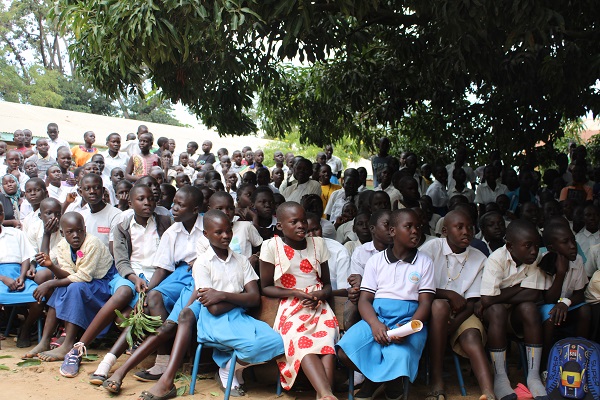ADJUMANI-The inadequate classrooms and lack of washrooms in Adjumani Girls’ Primary School are likely to affect the performance of the learned.
This reporter has established that the school has an enrolment of 1,459 with 827 girls and 632 boys using only 14 classrooms, yet the expected number of classrooms is 27, according to the government’s classroom pupil ratio leaving a gap of 13 classrooms.
The school has 10 latrines the expected number of latrine stances is 36 and the gap is 22 latrines the school only has 18 teachers, yet the ceiling is 29 teachers
The headteacher of the school, Rebecca Konyio Gobbi said, “The classroom pupil ratio is at 1:105, and the pupil latrine ratio is at 1:145, and a high pupil-teacher ratio due to the high enrolment.”
The head teacher revealed that the few latrine facilities are being shared by the teachers, and pupils said more teachers, classrooms, and latrines are needed for the school to operate fully.
Esther Okudra, the community development officer who doubles as the chairperson of the school’s management committee and an old girl of the school, observed that the lack of sanitary facilities, especially washrooms in the school needs to be addressed because it is key to the menstrual hygiene of the girls.
“The absence of washrooms and other necessary facilities are going to drive many young girls out of school, I want to appeal to the parents to work hard and support the school to be able to establish washrooms for girls to use.”
Fr Andrew Inyaga, the former education secretary of the Arua diocese challenged the parents of the school to prioritize the education of their children by working hard and providing a conducive learning environment.
“Without education, we shall not get people to serve the nation, as you pray you should also work, don’t only concentrate on reading but your body needs exercise to remain healthy.”
Igama Nobert, the acting Human resource officer Adjumani district who is also an old boy of the school, pledged to support the school by mobilising others so that more latrines are built to ensure effective learning in the school.
“I have keenly listened to the challenges, I will share with the District Education Officer [DEO] but individually I will ensure I support the school and contribute towards addressing the gaps,” Igama noted.
He also promised to work with the DEO to ensure more teachers are deployed in the school.
Philip Akuku Kayakya the senior district education officer of Adjumani acknowledged that the challenges of classrooms, latrines, and teachers are common in the district, attributing it to the presence of refugees.
“The district has a gap of 275 classrooms, 6020 desks for learners, a gap of 483 staff houses, and a gap of 300 teachers to match the standards,” Akuku said
He added that the district has a latrine shortage of 1724 stances and the standard ratio is 1latrine to 96 learners, 1 desk for 8 children, and 1 classroom to 120 learners.
Akuku however, said the department does not have funds but is hopeful that the district council may allocate more than three classrooms to Adjumani Girls’ Primary School to solve the challenge.
He also said last in the first quarter they got a donation of Shs 500 million from the Office of the Prime Minister which was prioritised for the rehabilitation of classrooms.
He said another source of funding could be through the Development Response to Displacement Impact Project [DRDIP] by the community application which the district has got little control over being a community-led project.
Adjumani Girls’ Primary School was founded by the Verona fathers in 1953. It was attached to Adropi Sub-county primary school now the present Cesia Boys Primary School. Adjumani Girls’ Primary School is one of the urban schools that has enrolled 241 refugees.
Buy your copy of thecooperator magazine from one of our country-wide vending points or an e-copy on emag.thecooperator.news
